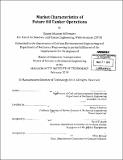| dc.contributor.advisor | Henry S. Marcus. | en_US |
| dc.contributor.author | Willemann, Simmy Dhawan | en_US |
| dc.contributor.other | Massachusetts Institute of Technology. Department of Mechanical Engineering. | en_US |
| dc.date.accessioned | 2014-07-11T21:08:46Z | |
| dc.date.available | 2014-07-11T21:08:46Z | |
| dc.date.copyright | 2013 | en_US |
| dc.date.issued | 2014 | en_US |
| dc.identifier.uri | http://hdl.handle.net/1721.1/88396 | |
| dc.description | Thesis: S.M., Massachusetts Institute of Technology, Department of Civil and Environmental Engineering, February 2014. | en_US |
| dc.description | Thesis: S.M., Massachusetts Institute of Technology, Department of Mechanical Engineering, February 2014. | en_US |
| dc.description | Cataloged from PDF version of thesis. | en_US |
| dc.description | Includes bibliographical references (pages 128-129). | en_US |
| dc.description.abstract | This work analyzes the market characteristics of future oil tanker operations with a particular emphasis on those aspects which will have a potential impact on the design of future vessels. The market analysis model used is unique in that it segments historical distributions of time charter equivalent rates to account for market variability in ship design. Market cycles, trade routes, refinery locations, cargo prices, and fuel prices are all targeted as key evolving factors over the next twenty-five years and are considered in a sensitivity analysis on metrics of profitability and tanker operations. The study's analytical approach to accounting for market factors in speed selection can serve as a tool for shipowners in scenario planning by better preparing them for projected market conditions. It is intended that shipowners and operators would refer to this analysis in conjunction with market forecasts to determine which speed a ship should be designed at to maximize return. If the market is expected to be reaching a peak, this study's model can determine how much higher TCE rates need to be than historical values to justify speeding up by a given increment. Though slow steaming saves costs when the market is down, to fully take advantage of market peaks and maximize profit over a ship's lifetime, ships must have sufficient reserve power. | en_US |
| dc.description.statementofresponsibility | by Simmy Dhawan Willemann. | en_US |
| dc.format.extent | 129 pages | en_US |
| dc.language.iso | eng | en_US |
| dc.publisher | Massachusetts Institute of Technology | en_US |
| dc.rights | M.I.T. theses are protected by copyright. They may be viewed from this source for any purpose, but reproduction or distribution in any format is prohibited without written permission. See provided URL for inquiries about permission. | en_US |
| dc.rights.uri | http://dspace.mit.edu/handle/1721.1/7582 | en_US |
| dc.subject | Civil and Environmental Engineering. | en_US |
| dc.subject | Mechanical Engineering. | en_US |
| dc.title | Market characteristics of future oil tanker operations | en_US |
| dc.type | Thesis | en_US |
| dc.description.degree | S.M. | en_US |
| dc.contributor.department | Massachusetts Institute of Technology. Department of Civil and Environmental Engineering | |
| dc.contributor.department | Massachusetts Institute of Technology. Department of Mechanical Engineering | |
| dc.identifier.oclc | 881816201 | en_US |
